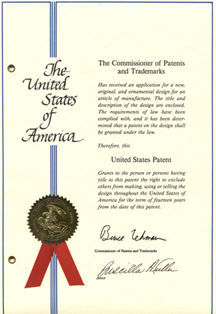Inventor, brilliant idea patent search strategy!
Applying for and maintaining a commercial U.S. patent for 15 years is very expensive. Inventors either seeking a Utility patent for an engineering or technology advancement or a Design patent -for aesthetic or exact geometry need to consider a thorough patent search to help insure being awarded the patent and avoid patent infringement. Infringement is the commission of a prohibited act defined by the claims or exact wording used without permission from the patent owner. The definition of patent infringement may vary by jurisdiction, but it typically includes using or selling the patented invention. Patent law varies by territory and in many countries, use is required to be for commercial purpose to constitute infringement. Permission to use a patent or claim may be in the form of a royalty or license agreement. We suggest refer to and use the provided step by step patent search strategy before conducting a U.S. Patent Search.
Search preparation and documentation
The search process, may takes hours to days to search and evaluate results, based on the complexity of the patent or invention. Record the details of your search process such as the databases and keywords used and where the patents/published patent applications were retrieved.
U.S. Patent Search Strategy
- Brainstorm terms describing your invention. Try to think of alternative words to describe your concept. For example, an umbrella could also be called a parasol or a sunshade.
- Conduct a keyword search using Patent Public Search. You can begin with a broad search for your main concept, and then narrow the search results by adding additional features of your invention. Review the front pages of patents and published patent applications, eliminating those that are irrelevant. Guidance on how to search is available in our Quick Reference Guides.
- Conduct an in-depth review of the documents found by your search. Review in detail the complete patents and published patent applications you found that are similar to your invention. Don’t forget to review the drawings, specification and claims for similarities to your invention.
- Expand the search with relevant CPC classifications. Go to the Classification Resources page and select the CPC classification system. Find a relevant classification and use it in a classification search in Patent Public Search’s Advanced Search with the .CPC. field code.
- Review cited references. The front page of a patent includes a section of cited references provided by the applicant and/or the patent examiner. Review the U.S. patents and published patent applications that a patent has cited and/or the patents that have cited them since their publication. Patent Public Search can provide a search of both the backward and forward citations.
- Broaden your search with foreign patents, non-patent literature and/or a patent professional’s search. Check Espacenet, the European Patent Office’s worldwide patent publication database of over 140 million patent publications. Also search books, journals, websites, technical catalogs, and conference proceedings in the applicable field. You may want to hire a registered patent attorney or patent agent to review the search.
Additional Resources
VIDEO: CBT (computer-based training) tutorial with a detailed review of the step-by-step strategy. covering searching using Cooperative Patent Classification (CPC).
Search assistance is available at a Patent and Trademark Resource Center (PTRC) PTRC library staff are available to provide training on U.S. patent search processes and research tools including Patent Public Search. For the PTRC nearest you, check www.uspto.gov/ptrc.
Happy Patenting!

